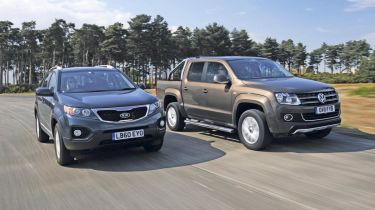VW Amarok vs Kia Sorento
It’s more comfortable, refined and frugal, and Kia has edge on quality and pace. There’s also the extensive seven-year warranty.
THE extra space and ruggedness of a pick-up is great in theory – but conventional SUVs provide just as much, if not more, off-road ability, plus the promise of a more cultured driving experience. So can the VW beat one of the class leaders, in the shape of the Kia Sorento?
The original version of the 4x4 was critical to the brand’s change of fortunes in the UK, and the second-generation model arrived last year to build on these solid foundations. Its design played a major part in that success, and the Sorento wears Kia’s trademark bow-tie grille and chrome detailing.
It’s dwarfed by the Amarok – by more than 500m in length and nearly 90mm in height – so it doesn’t pack such a big visual punch. Yet silver roof bars, chunky bumpers and tough-looking skid-plates lend the Kia an understated air of purpose. And despite its smaller size, the Sorento manages to stand shoulder-to-shoulder with the double-cab for visual appeal.
Incredibly, the Amarok doesn’t feel any more spacious inside, and it’s the smaller Kia that gets our vote for rear passengers, as it boasts more legroom and a greater impression of space. Our KX-2 also had another trick up its sleeve, as it features seven seats as standard, providing added family appeal. Make use of its third row, and luggage space predictably suffers, though. Space drops from 531 litres with five seats in place to a mere 111 litres when the rear bench is in use.
Used - available now

2020 Peugeot
508
57,957 milesAutomaticDiesel1.5L
Cash £11,999
2021 Ford
Fiesta
9,955 milesAutomaticPetrol1.0L
Cash £16,699
2023 Ford
Puma
18,363 milesAutomaticPetrol1.0L
Cash £16,899
2020 Ford
Kuga
24,644 milesAutomaticDiesel2.0L
Cash £25,799Up front, the Kia delivers a lower, more car-like driving position than the Amarok, with plenty of adjustment for the steering wheel and seat. Material quality in the Kia also stands up well to comparison with the VW, and it feels plusher and better built than the Amarok, with tighter panel gaps and more upmarket interior trim. It has plenty of kit, too. Heated leather seats, climate control, an iPod connection and cruise control are all standard. But sat-nav isn’t available as an extra-cost item as it is in the VW, so the only way to get integrated route-finding kit on the Sorento is to upgrade to the costly KX-3 Nav model – for another £4,185.
The Korean performs like a traditional SUV on the road, but that’s no bad thing in this case, as it’s streets ahead of the Amarok for mechanical refinement. Its gearchange is lighter and more precise, and the engine is quieter and smoother. Kia’s 2.2-litre diesel has 33bhp and 22Nm more than its rival, at 194bhp and 422Nm, so it’s faster, too. The SUV covered 0-60mph in a lively 8.8 seconds – that’s 3.4 seconds up on the Amarok. The differences were just as pronounced during our in-gear tests: the Sorento completed the drag from 50-70mph in fifth 2.1 seconds ahead of the VW, with a time of 7.8 seconds.
This superiority continues on twisty roads. The Kia is never going to rival one of VW’s hot hatches for agility but, compared to the unwieldy Amarok, it is more composed in corners. Its steering is more direct, too, so the Sorento is nimbler than its rival both in town and country. This is largely due to the commercial roots of the Amarok’s suspension. It uses unyielding heavy-duty leaf springs at the rear; this set-up ensures the car is capable of transporting heavy loads, but it’s no match for that of the Korean model when it comes to comfort or composure. The pick-up has an agricultural feel from behind the wheel.
Not only does the Sorento offer better performance, it leaves the Amarok in the shade with its efficiency, too. We hit a solid 32.1mpg in the SUV, but managed only 28.2mpg in the pick-up. The impact of this is mitigated to some degree by the new model’s tax-friendly status, and this will make it a tempting choice for buyers considering a big SUV.
The VW badge adds another layer to its appeal, yet Kia has consistently beaten its German rival in our annual Driver Power satisfaction survey. Plus, its car comes with an impressive seven-year warranty.
Factor in the Sorento’s more sophisticated dynamics and the day-to-day difficulties of living with a cumbersome pick-up, and the Koreans look to have this twin test sewn up.







